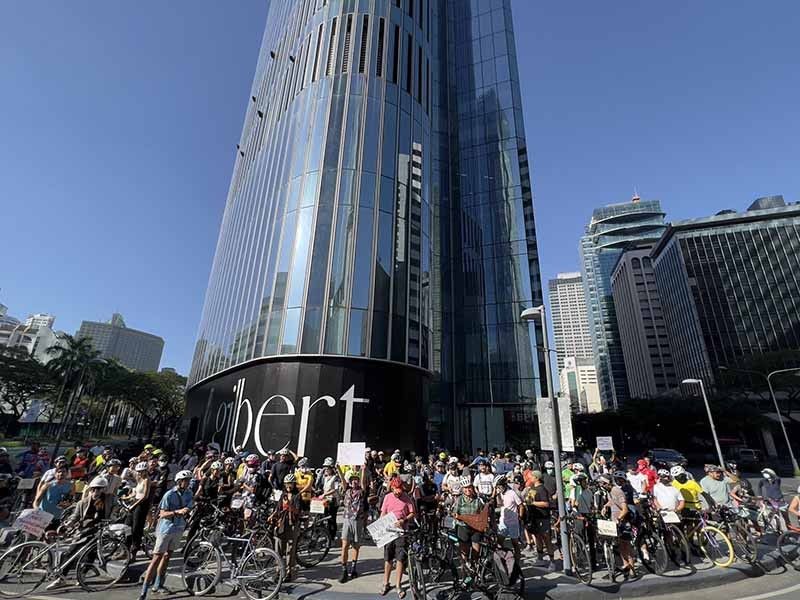Whatever happened to: The fight for protected bike lanes in Makati

MANILA, Philippines (Updated 5:58 p.m.) — Consultations on the protected bike lanes on Ayala Avenue in Makati — part of wider discussions on the safety and convenience of commuters and active transport users in the city's commercial business district — have ground to a halt with the suspension of meetings of a technical working group among advocacy groups and developer Ayala Land Inc. "until further notice."
The TWG, formed after cyclists and commuters protested plans to remove the protected bike lanes in favor of "sharrows" in February, ended its last meeting with no date set for when it will convene again, Alt Mobility PH director Ira Cruz told Philstar.com on Friday. He said the move could signal a further reversal of policies promoting biking and active mobility that were put in place during the pandemic lockdowns.
"This could set the tone for other local government units and properties," he said, noting that bike lanes in a "significant" part of the Ayala Land's Bonifacio Global City estate have also been removed. He said the company's lack of action on measures that are easily implemented has been a "huge disservice and compromises the safety" of commuters and cyclists in the Makati CBD.
"A lot of other cities have started — if not removing — not maintaining bike lanes," he said.
Although talks began with the protected bike lanes on Ayala Avenue, the discussion in the TWG was meant to cover commuter and pedestrian safety and convenience in the Makati CBD.
In a message to Philstar.com, an Ayala Land representative said: "The current 1.5-meter protected bike lanes will remain. Moving forward, we are studying the entire road allocation for all users with consultations from various stakeholders — including bikers." The representative could not say when the next meeting would be.
Cruz said the suspension is so the developer can consult a foreign firm on the design of the business district. Advocates are willing to engage with the design firm if asked but also said there are safety measures that can be implemented even before that happens, he added.
RELATED: To pedal is to navigate to a better world
Bike lane retained, other commitments set aside
Cruz said that while the protest led to the formation of the TWG and engagement between Ayala Land and transport coalition Make It Safer Movement (MISMo), little has been done aside from the retention of the protected bike lane on Ayala Avenue. Although the protected lane has been retained, it is also now only just 1.5 meters wide from the previous 3 meters.
A suggestion to put more bollards that would prompt motor vehicles to make wider turns to make sure they do not hit cyclists has also been ignored, Cruz said, adding this suggests a "lack of commitment to protect vulnerable road users."
Enforcement of the bike lanes — to prevent motor vehicles from using them — has not been done and there has been no progress in resolving "conflict points" like loading and unloading zones where vehicles encroach into the lanes.
Even the provision of end-of-trip facilities like bicycle parking has been problematic, he said, adding that there have been reports of Makati workers' bikes being impounded for alleged improper use of racks. Cruz said there are too few racks and that these weren't designed to accommodate different types of bicycles.
RELATED: QC gives away 200 bicycles to help workers with costs of commuting
What are 'sharrows' and why do they matter?
In its announcement of the shift to "Shared Lane Markings," community page Make It Makati said these would replace protected bike lanes "to better serve the commuting public and in preparation for the provision of more and bigger transit sheds along Ayala Avenue," a position that transport advocates, like Cruz, have pointed out as disingenuous and pits cyclists against commuters.
According to Bicycling magazine, sharrows are not meant to replace bike lanes and are meant for slower-moving streets "where cyclists and drivers must coexist in the same lane" like neighborhood streets. "In theory, if you ride where the sharrow is placed, you won’t find yourself squeezed in a lane too narrow for cars and bikes together," it also added, although Metro Manila cyclists who have to fight for space with cars, buses and motorcycles even when there are bike lanes may disagree.
Carving out a lane for buses and jeepneys from the bike lane prioritizes private vehicles, Cruz said, even if — citing a Makati Business Club survey to find the transport mix of Makati employees — only "30-35% of people who work in Makati have private vehicles."
Citing bike counts by partner organizations, Cruz said an average of 2,364 use the bike lanes daily. Writ larger, a 2022 Social Weather Stations survey suggested that there are four bicycle owners for every car owner in the Philippines.
Bike lanes are part of the government's transportation plan
The Department of Transportation in January announced that it will be testing an Active Transport Infrastructure Improvement Program that would "include widening of pedestrian walkways and protected bi-directional bike lanes."
The move is meant to encourage more people to leave their private vehicles "at home through building better and more active transport and mass transportation systems."
In May, the department said it is aiming to expand the 564 kilometers of protected bike lanes — advocates counter that painted bike lanes are not really protected — to 2,400 kilometers by 2028.
"As we rethink mobility and shift our focus on the most vulnerable road users, the call for responsibility and accountability on the road is further reiterated," DOTr said then.
"Everyone is also enjoined that all road users, particularly those who are most at risk, deserve uncompromised safety on the road." — with Ramon Royandoyan
- Latest
- Trending



























